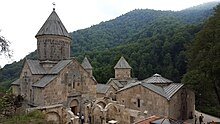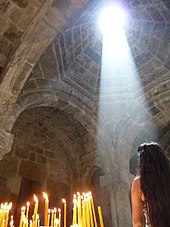Haghartsin Monastery
The monastery Haghartsin or Hagarzin ( Armenian Հաղարծին ) is a former convent of the Armenian Apostolic Church in the northern Armenian province of Tavush . The origins of the monastery go back to the 10th century.
location
The monastery is located about 18 kilometers from the city of Dilijan on a gorge of the Aghstafa River in a temperate rainforest with numerous oaks. The ruins of the village of Haghartsin, from which it takes its name, are about two kilometers from the monastery. Another medieval monastery, Goshavank , is located in the village of Gosha, a few kilometers away.
Building description
The monastery complex consists of several churches, two Gawiten (one is now a ruin), a burial chamber of two kings from the Kiurikid dynasty (a side branch of the Bagratids ) and a refectory . The buildings were built between the 10th and 14th centuries. Like Goshavank, Haghardzin is not surrounded by defensive walls.
One of the oldest buildings in the monastery is the Surb Grigor ( Gregory the Illuminator ) church from the 10th century. The building is a cross-domed church with side chapels in all four corners. From the outside, the building is rectangular. Inside, the floor plan is cross-shaped. As a typical example of Armenian church architecture, the small central church space is crowned by a dome with an octagonal drum . The drum and dome of the building rest on pillars. The vestibule (gawit) has a square floor plan. Their hipped roof with an open hole in the middle is reminiscent of Armenian farmhouses of the Glkhatun type . The remains of a burial chamber of two kings (Smbat and Gagik) from the Kiurikid dynasty have been preserved on the south wall of the church. A second gawit is rectangular. It was built in the 12th century.
The small cross- domed church of St. Stepanos looks like a small copy of the main church. It was built in 1244 from sky blue basalt stone.
The church Surb Astvatsatsin (( Armenian Սուրբ Աստվածածին , "Holy Mother of God "), western Armenian Surp Asdwadsadsin , other transcriptions Surp Astvatsatsin, Surb Astuacacin, Surb Astwazazin ) is the largest church in the monastery complex. It was built in the 11th century, probably destroyed by the Seljuks and rebuilt in the years 1281–1287 under the patronage of Ter Hovhannes and Ter Sargis. Surb Astvatsatsin is also a cross-domed church. Its facade is richly decorated. The south entrance has decorative strips on which clover leaves are depicted. All walls except the west side have two triangular niches ( Armenian niches) on the outside. Its faceted dome also rests on a drum. The pendentives, spherical triangles, allow the round dome to be supported by a square made up of four arches. Between the penditives there are several rows of arches , which in turn rest on columns.
Two men are depicted in the group of sculptures on the east wall of the church. They point to a model of a church set up between them and point to a dove with half-spread wings. Possibly the roof covering of the model shows the original appearance of the dome of the church. The two men are depicted in great detail. Her well-groomed full beards and large almond-shaped eyes have individual features and are finely crafted. Both men wear different monastic robes. Obviously the right figure is richer than the left. Possibly they represent the founder and first head of the monastery as well as his assistant.
The architects Minas, Movses and Grigores built the refectory (the dining room) in 1248. It is considered one of the most important examples of medieval architecture in Armenia. Columns divide the building into two square halves, which are topped by crossing arches. The inner walls are provided with stone benches. There is a wide archway for the many pilgrims who visit the monastery.
There are numerous other chapels around the monastery, most of which have now been destroyed. Several khachkars can be visited in the monastery and in the vicinity . Some of these are of high artistic value, such as the 13th-century memorial stone with its rich ornamental decoration, which is set up next to the south door of the Surb Astvatsatsin church, and the works of the stonemason Pavgos, including a kachkar made in 1291 with the name of the stonemason. It is considered a masterpiece. In the center of the stone a cross can be seen on a shield-shaped rosette above an eight-pointed star, which is surrounded by several layers of finely worked ornaments. They depict a complicated combination of floral and geometric motifs that do not repeat themselves.
A bronze head weighing 350 kilograms discovered during excavations can be seen in the Historical Museum in the capital Yerevan. It is dated to the year 1232.
history
Monks who had fled the persecution of Christians in western Armenia, which was ruled by the Byzantine Empire , probably founded the monastery in the 10th century. In the 11th century the Seljuks ravaged the monastery during their advance into Armenia . King Giorgi III. of Georgia and local Armenian princes had it restored in the 12th century. The monastery flourished under the ruler Khachatur Taronatsi, who was also a well-known scientist and musician. He had the Surb Grigor Church renovated in 1184. Ten years later (1194) the construction of another church began. The Gawit, which was built in front of the Surb Grigor church to the west, was donated by the noble Ivane Zakarian with the support of his vassals Artavazd and Atanes.
In 1671 and 1681 the three churches of Surb Stepanos , Surb Grigor and Surb Astvatsatsin were extensively renovated. Troops of the Aga Mohammed Khan , the Shah of Persia , ravaged the monastery at the end of the 18th century during the campaign. In 1861 the monastery was resumed. In 1901 the reconstruction work was completed. Between 2008 and 2013, the monastery was renovated with Arab donations.
Web links
Individual evidence
- ↑ a b c d e f g h i j k Haghartsin Monastery Complex, Armenia | World Building Directory | Buildings. Retrieved November 8, 2017 .
- ↑ a b c www.mediable.com: Haghartzin Monastery 10-13 c - Armenica.org. Retrieved November 8, 2017 .
- ↑ a b c d e Haghartsin Monastery - Armeniapedia.org. Retrieved November 8, 2017 .
- ↑ Armenia Fund Will Upgrade Haghartsin Monastery With Donation from HH the Ruler of Sharjah ( Memento of the original from October 4, 2011 in the Internet Archive ) Info: The archive link was automatically inserted and not yet checked. Please check the original and archive link according to the instructions and then remove this notice. .
Coordinates: 40 ° 46 ′ 6.6 " N , 44 ° 53 ′ 27.2" E





